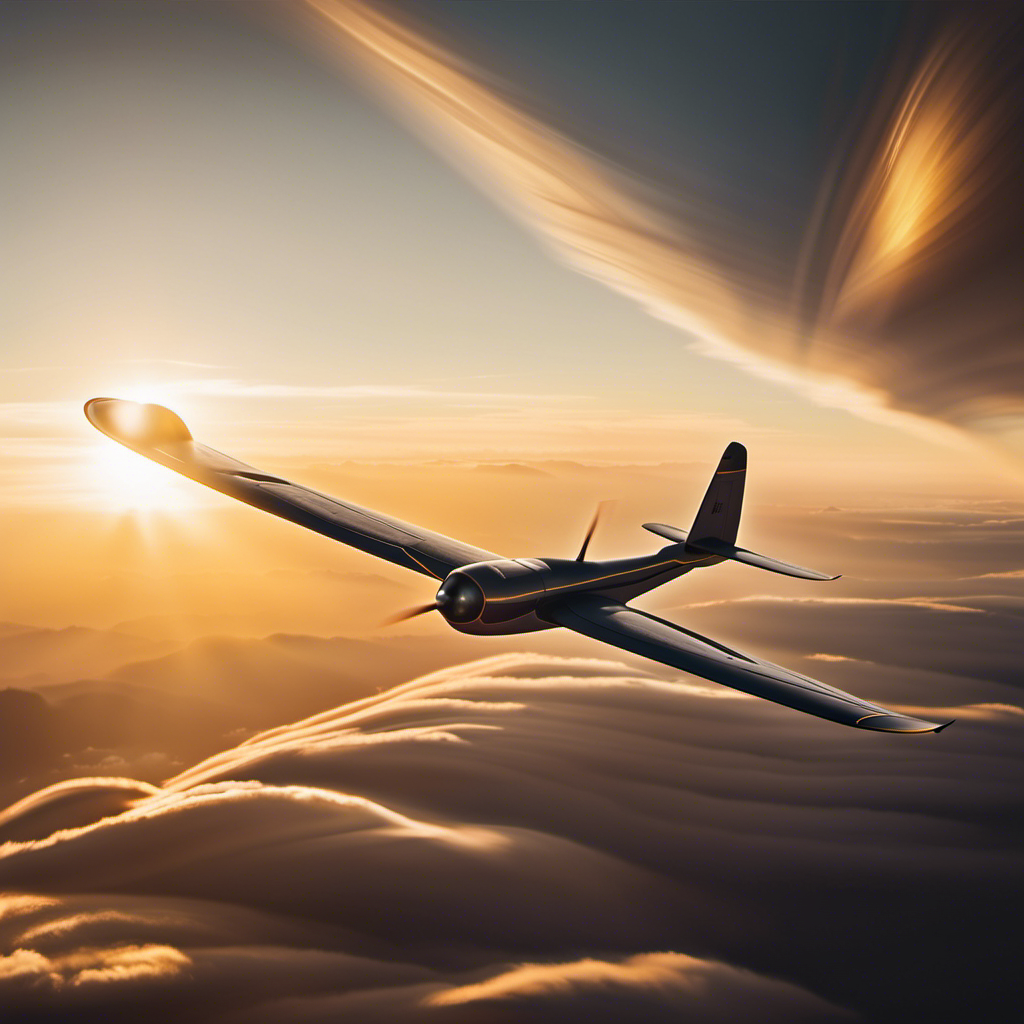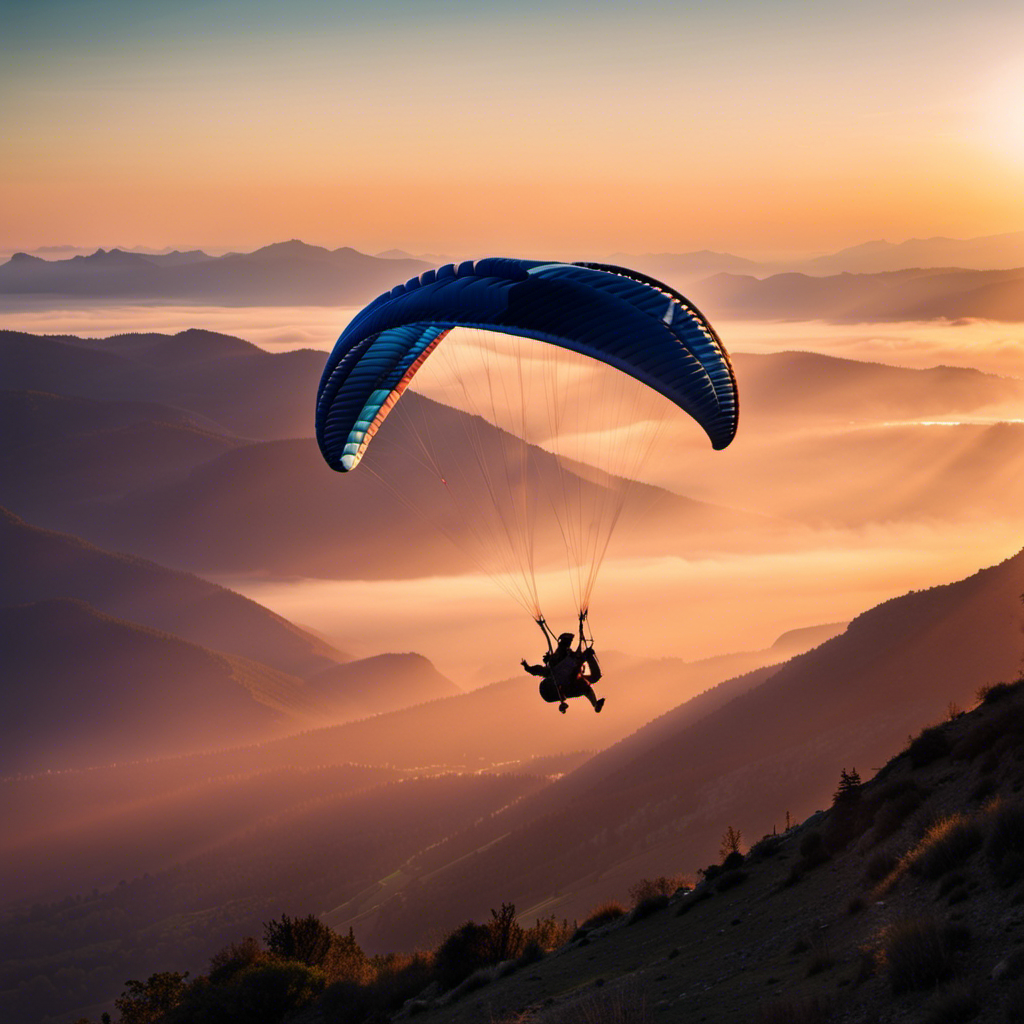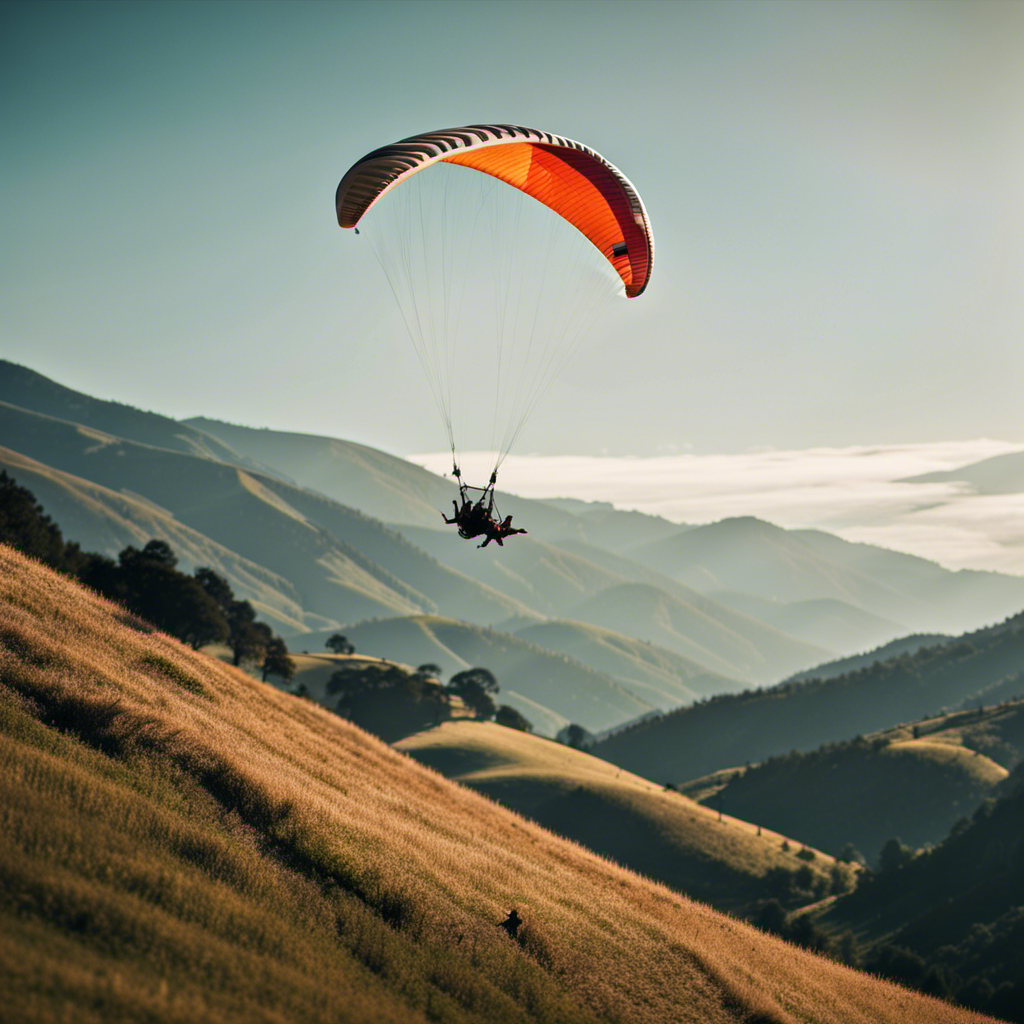Did you know that gliders can stay in the air for hours without an engine? It’s true! In this article, I will explore the fascinating world of gliding and reveal the secrets that enable them to soar effortlessly through the skies.
We will explore the basics of glider flight, examining the intricate design and construction of these aircraft. Gliders are designed to be lightweight and have a high aspect ratio, which allows them to generate lift from the air flowing over their wings. This lift, combined with careful control of the glider’s angle of attack, allows it to stay aloft for extended periods of time.
We will also uncover the techniques used to launch and sustain their flight. Gliders can be launched using various methods, such as being towed by a powered aircraft or by using a winch or a bungee cord. Once in the air, glider pilots rely on thermal updrafts, ridge lift, and wave lift to maintain and gain altitude. These natural sources of lift allow gliders to stay airborne for hours, covering great distances without the need for an engine.
So, buckle up and prepare to be amazed by the science and skill behind glider aviation. Glider flight is a testament to the ingenuity of human engineering and the beauty of harnessing the power of nature. Whether you’re a seasoned pilot or simply curious about the wonders of flight, exploring the world of gliders is sure to leave you in awe.
Key Takeaways
- Gliders stay in the air by utilizing rising columns of warm air called thermals.
- Another technique used by gliders is ridge soaring, where they fly along the edge of a mountain or hill to take advantage of the updraft created by the wind hitting the slope.
- Building a strong foundation in safety procedures is essential for glider pilots to enhance their chances of safe landing and to protect themselves and their aircraft.
- Transitioning to advanced gliding techniques and competitions requires specialized training programs and provides an opportunity to enhance skills, experience, and unlock the full potential of the aircraft.
The Basics of Glider Flight
To understand the basics of glider flight, you need to know how gliders stay in the air. The key to this is lift generation. Lift is the force that opposes the weight of the glider and keeps it airborne. It is created by the interaction between the glider’s wings and the air.
As the glider moves through the air, the shape of its wings, called airfoils, creates a pressure difference. The air flowing over the curved upper surface of the wing moves faster and creates lower pressure, while the air flowing under the wing moves slower and creates higher pressure. This pressure difference generates lift, allowing the glider to stay aloft.
Understanding lift generation is crucial for optimizing glider performance, as it determines how efficiently the glider can stay in the air and maneuver.
With this knowledge of lift, we can now delve into the design and construction of gliders, which further enhance their performance and capabilities.
The Design and Construction of Gliders
You can learn about the design and construction of gliders by studying their aerodynamic features and materials used. Here are four key design principles and aerodynamics principles to consider:
-
Wing shape: Gliders typically have long, narrow wings with a high aspect ratio, allowing for efficient lift generation and low drag.
-
Wing loading: The weight of the glider divided by the wing area determines the wing loading. Lower wing loading results in better gliding performance.
-
Control surfaces: Gliders have control surfaces such as ailerons, elevators, and rudders to control pitch, roll, and yaw respectively.
-
Materials: Gliders are often constructed using lightweight yet strong materials like carbon fiber composites or fiberglass, ensuring durability and reducing weight.
Understanding these principles helps in optimizing the design and construction of gliders for improved flight performance.
Now, let’s explore the next section on launching and sustaining flight.
Launching and Sustaining Flight
Launching and sustaining flight requires a smooth and controlled takeoff, as well as maintaining the right balance between lift and gravity. Once the glider is released from its tow plane, it relies on a combination of thermals and ridge soaring to maintain altitude.
Thermals are columns of rising warm air that gliders can use to gain altitude. By flying in circles within a thermal, the glider can climb higher and continue its flight.
Ridge soaring, on the other hand, involves flying along the edge of a ridge or mountain, where the wind is forced upward, creating lift.
To maintain balance and stability, careful attention must be paid to the weight and balance of the glider. Adjustments can be made by shifting ballast or adjusting the position of the pilot.
With these techniques, the glider can stay in the air for extended periods, controlling its movement effortlessly.
Controlling Glider Movement
Controlling the movement of a glider involves maintaining balance and stability through careful adjustments of weight and position. Aerodynamic principles and pilot input play a crucial role in maintaining control during flight. By understanding and applying these principles, pilots can manipulate the glider’s flight path and achieve desired maneuvers.
To control a glider, pilots utilize a combination of weight shifting and control surface inputs. By shifting their body weight, pilots can influence the glider’s pitch and roll. This is achieved by moving the center of gravity and adjusting the distribution of weight between the wings. Additionally, control surfaces such as ailerons, elevator, and rudder provide further control by altering the airflow and generating forces that affect the glider’s movement.
Aerodynamic Principles Pilot Input and Control
- Center of Gravity Shifting body weight
- Ailerons Adjusting roll
- Elevator Controlling pitch
- Rudder Managing yaw
By skillfully manipulating these controls, pilots can navigate through the air with precision and finesse. The mastery of glider control is essential for safe and efficient flight. Understanding the aerodynamic principles and pilot inputs is crucial for maintaining stability and achieving desired flight characteristics.
Transitioning to the subsequent section on glider safety and emergency procedures, it is important for pilots to have a thorough understanding of how to react in unexpected situations while maintaining control of the glider.
Glider Safety and Emergency Procedures
When it comes to glider safety and emergency procedures, it’s important to be prepared for unexpected situations. As a glider pilot, I understand the importance of having a solid plan in place to ensure a safe landing in case of an emergency.
Here are four key aspects of glider safety and emergency procedures:
-
Glider emergency landings: Pilots are trained to assess the situation and choose a suitable landing spot in case of an emergency. This involves considering factors like wind direction, obstacles, and the condition of the terrain.
-
Glider parachute systems: Some gliders are equipped with parachute systems that can be deployed in case of an unrecoverable situation. These systems provide an additional layer of safety and can help ensure a controlled descent.
-
Emergency communication: Pilots are trained to use emergency communication devices, such as radios or satellite phones, to call for help and provide their location in case of an emergency.
-
Emergency drills and training: Regular practice of emergency procedures and drills is crucial to ensure pilots are well-prepared to handle unexpected situations.
By being knowledgeable and well-prepared in these aspects of glider safety, pilots can enhance their chances of a safe landing in emergency situations.
Transitioning to the next section about advanced gliding techniques and competitions, it’s important to build a strong foundation in glider safety procedures to safely explore the world of gliding.
Advanced Gliding Techniques and Competitions
Transitioning to the world of advanced gliding techniques and competitions, I can further enhance my skills and experience by participating in specialized training programs. These programs delve deep into the intricacies of glider aerodynamics, allowing pilots to unlock the full potential of their aircraft.
One key technique is known as thermalling, where pilots use rising columns of warm air to gain altitude and extend their flight time. By studying the science behind these thermals and learning how to effectively locate and utilize them, pilots can stay aloft for longer periods and cover greater distances.
Additionally, advanced gliding techniques include ridge soaring, where pilots fly along the edge of a mountain or hill to take advantage of the updraft created by the wind hitting the slope. This technique requires precise control and understanding of glider aerodynamics to maximize lift and maintain a steady flight path.
Competitions provide an opportunity to showcase these advanced skills, as pilots compete in tasks such as speed races, distance flights, and accuracy landings. The combination of technical knowledge, analytical thinking, and honed flying skills makes participating in advanced gliding techniques and competitions a truly exhilarating experience.
Frequently Asked Questions
What is the maximum altitude that a glider can reach?
The maximum altitude a glider can reach depends on various factors such as glider performance, weather conditions, and pilot skill. Achieving higher altitudes requires efficient use of lift, thermals, and ridge soaring techniques.
How long can a glider stay in the air without any propulsion?
Glider endurance is determined by efficient glider energy management. By optimizing factors such as weight, aerodynamics, and weather conditions, a glider can stay in the air for several hours without any propulsion, using only the energy from the surrounding air.
Can gliders fly at night or in adverse weather conditions?
Yes, gliders can fly at night utilizing instruments such as GPS and lights. However, flying in storms is highly dangerous due to the unpredictable nature of severe weather conditions and strong winds.
Are gliders equipped with any communication devices?
Yes, gliders are equipped with communication technology to ensure safety. Emergency procedures are communicated through radios and transponders. These devices allow pilots to communicate with air traffic control and other aircraft in case of emergencies.
How do gliders handle turbulence and thermal currents?
Glider stability is maintained through careful wing design. Turbulence is handled by adjusting the control surfaces, such as ailerons and elevators. Thermal currents are utilized by gliders to gain altitude and extend flight time.
Conclusion
In conclusion, gliders are able to stay in the air through a combination of design, skillful piloting, and the use of natural air currents.
By carefully constructing their wings and bodies to maximize lift and minimize drag, glider designers have created aircraft that can glide for extended periods of time.
Skilled pilots are able to take advantage of rising air currents, known as thermals, to gain altitude and stay aloft. With precise control and maneuvering, glider pilots can navigate the skies with ease.
So, next time you see a glider soaring gracefully above, ask yourself, how do they do it?
With a heart that soars as high as the skies, Aria, affectionately known as “Skylark,” is the driving force behind Soaring Skyways. Her journey into the gliding world began as a young dreamer gazing up at the soaring birds, yearning to experience the weightlessness and freedom they embodied. With years of experience both in the cockpit and behind the scenes, Aria’s commitment to the gliding community is unwavering.










